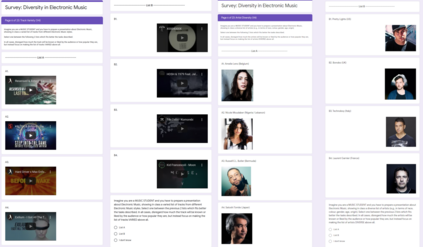Shared practices to assess the diversity of retrieval system results are still debated in the Information Retrieval community, partly because of the challenges of determining what diversity means in specific scenarios, and of understanding how diversity is perceived by end-users. The field of Music Information Retrieval is not exempt from this issue. Even if fields such as Musicology or Sociology of Music have a long tradition in questioning the representation and the impact of diversity in cultural environments, such knowledge has not been yet embedded into the design and development of music technologies. In this paper, focusing on electronic music, we investigate the characteristics of listeners, artists, and tracks that are influential in the perception of diversity. Specifically, we center our attention on 1) understanding the relationship between perceived diversity and computational methods to measure diversity, and 2) analyzing how listeners' domain knowledge and familiarity influence such perceived diversity. To accomplish this, we design a user-study in which listeners are asked to compare pairs of lists of tracks and artists, and to select the most diverse list from each pair. We compare participants' ratings with results obtained through computational models built using audio tracks' features and artist attributes. We find that such models are generally aligned with participants' choices when most of them agree that one list is more diverse than the other, while they present a mixed behaviour in cases where participants have little agreement. Moreover, we observe how differences in domain knowledge, familiarity, and demographics can influence the level of agreement among listeners, and between listeners and diversity metrics computed automatically.
翻译:评估检索系统结果多样性的共同做法仍然在信息检索社区中辩论,部分原因是在确定特定情景中多样性意味着什么以及了解最终用户如何看待多样性方面存在挑战。音乐信息检索领域不能排除在这一问题之外。即使音乐学或音乐社会学等领域在质疑文化环境中多样性的代表性和影响方面具有悠久的传统,但这种知识尚未被纳入音乐技术的设计和发展之中。本文侧重于电子音乐,我们调查听众、艺术家和对多样性有影响力的轨道的特点。具体地说,我们集中关注:1)了解所认识的多样性与计算方法之间的关系,以衡量多样性,2)分析听众的域内知识和熟悉程度如何影响这种所认识的多样性。为此,我们设计了用户研究,请听众对轨道和艺术家的组合进行对比,并从每一对口中选择最多样化的听众名单。我们把参与者的评级与使用音轨特征和艺术家属性的计算模型获得的结果进行比较。具体地说,我们关注的焦点是:1)了解所认识的多样性多样性与计算方法与计算方法之间的关系,2)分析听众的域内知识和熟悉度对多样性的影响如何。我们发现,这些模型一般而言,在参与者的选择中,在不同的领域里,他们之间,他们之间如何理解,他们之间如何相互一致。








